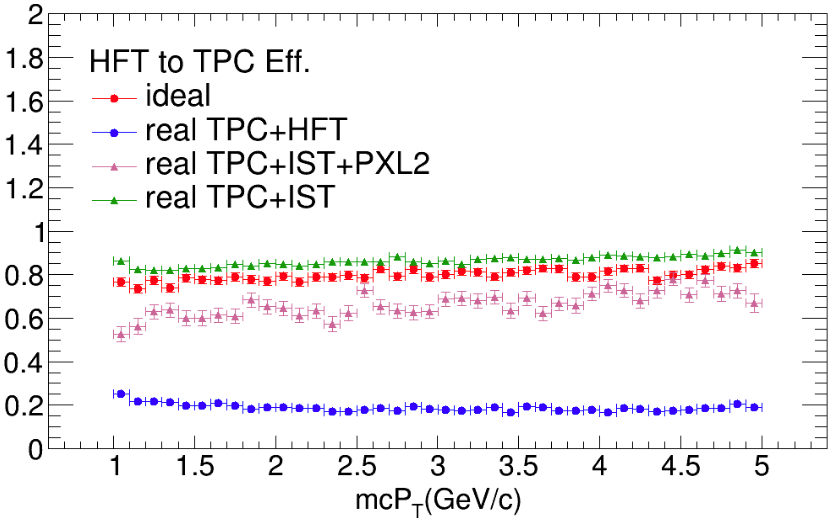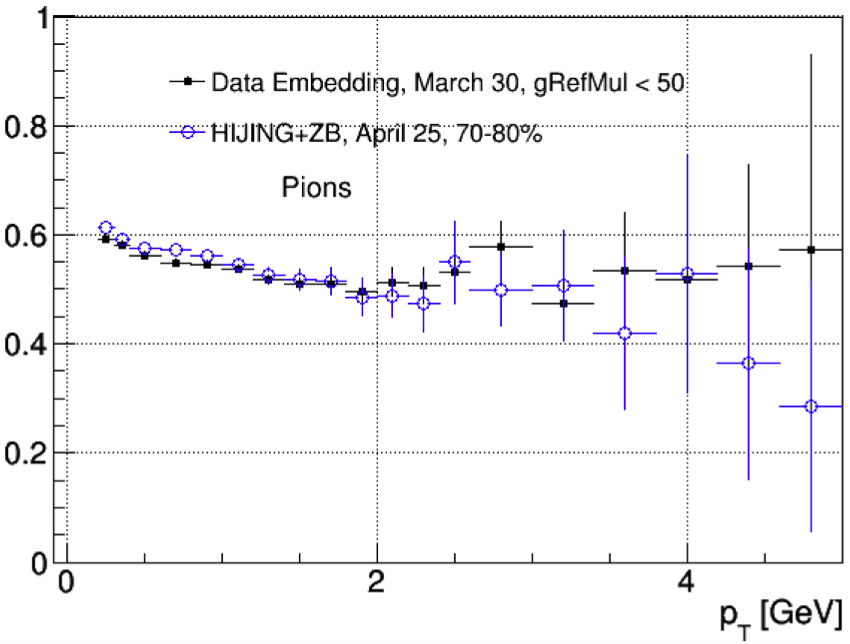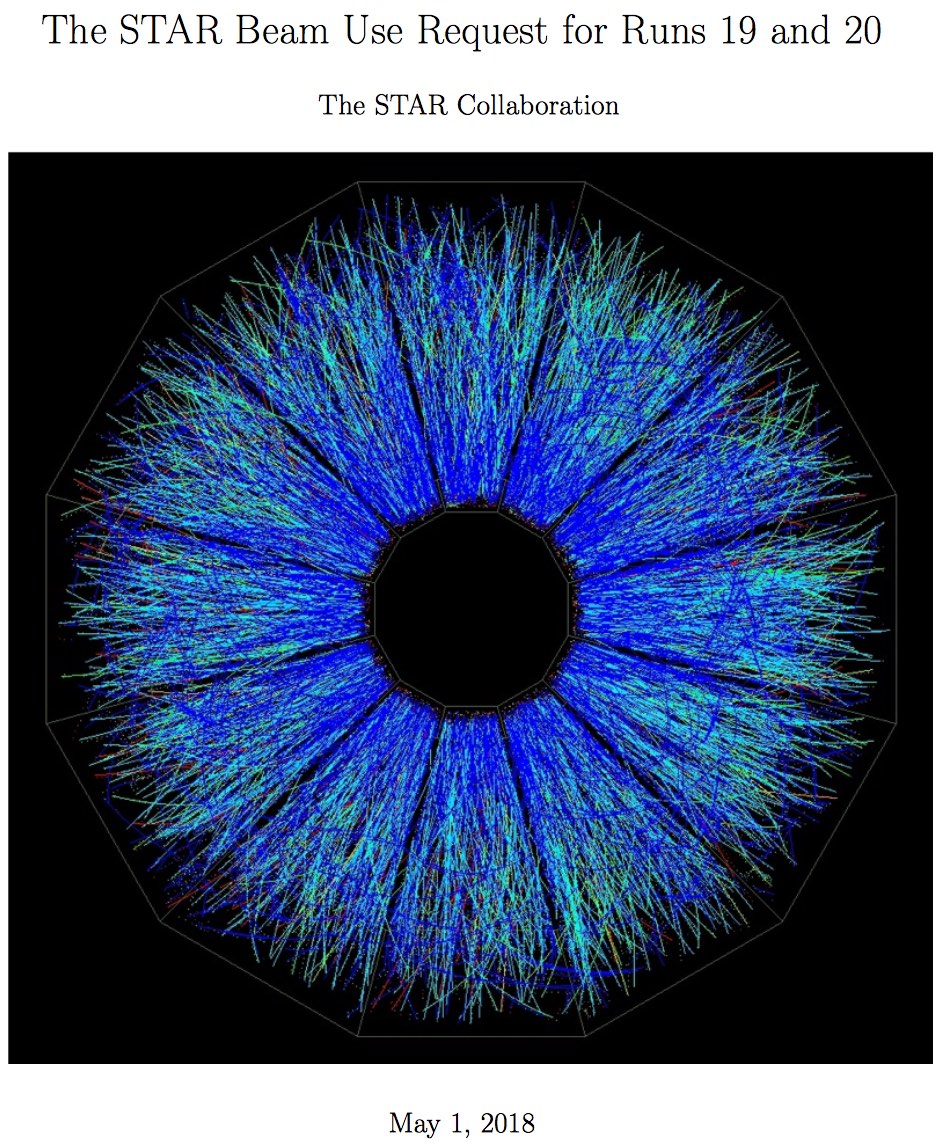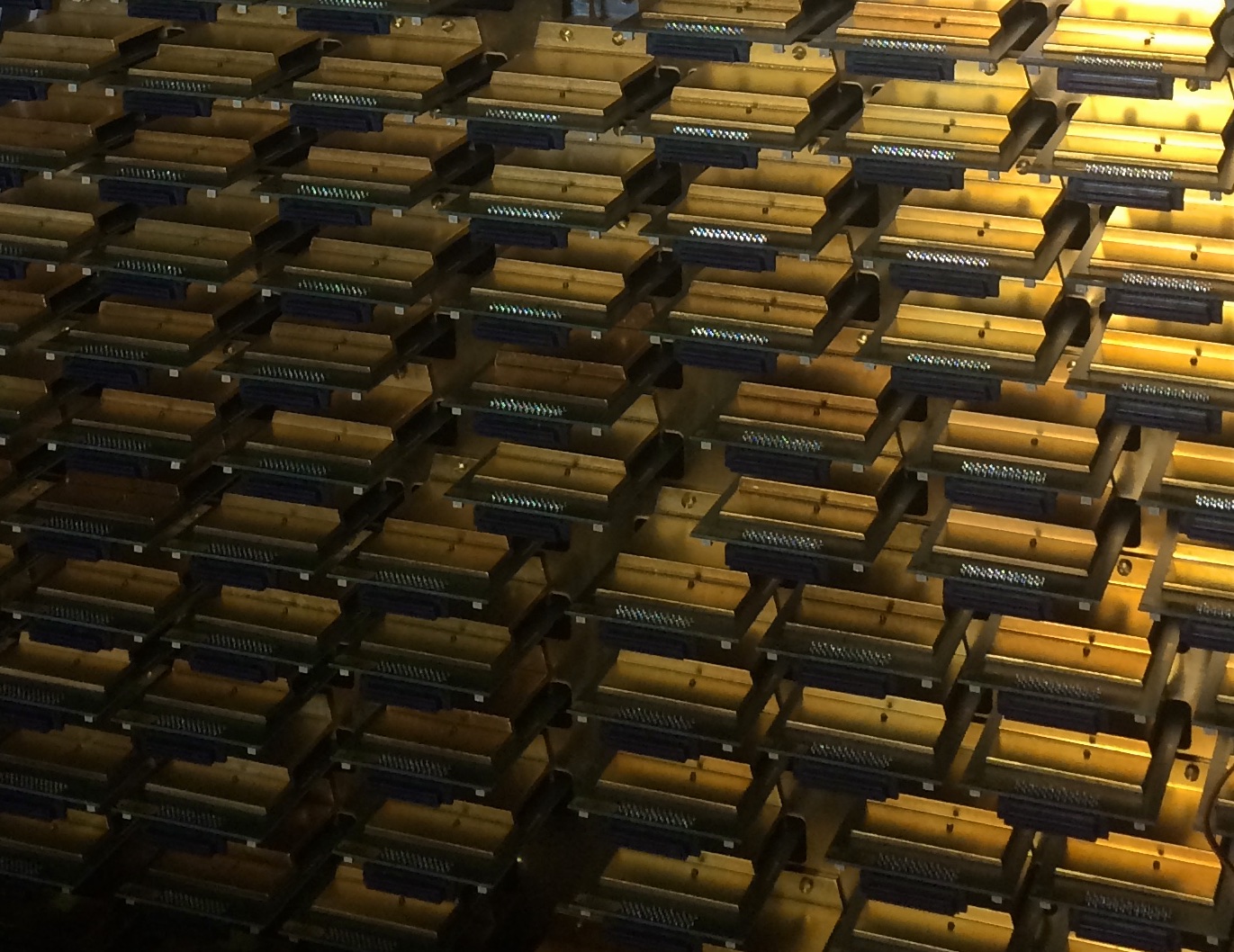April 2018
STAR Newsletter
April 2018 edition
Contents:
- From the Spokespersons
- Quark Matter Preparations
- S&C Update: HFT Embedding and Production
- Beam Use Request
- STAR arts
A note from the editor: as a collaboration-wide communication tool, this newsletter is set up to allow comments (subject to moderation against abuse), and all STAR Collaborators are welcome to do so! Please keep in mind that some content (including all comments) may be considered internal to the Collaboration and only accessible when logged into Drupal. Documentation is available here.
From the Spokespersons
(Zhangbu Xu - Co-Spokesperson)
Run 18 is well underway with isobar collisions already reaching their conclusion. We had requested CAD to steer the luminosity at a flat ZDC coincidence rate of 10 KHz, and it was amazing to see that this was routinely achieved for both Zr+Zr and Ru+Ru collisions for over 20 hours a fill. The physics data-taking started on February 15th, a week ahead of the schedule. We have taken data at DAQ rate of over 2200 Hz, accumulating 3 billion minimum-bias events of each species, which is a factor of 2 more than our initial projection in the BUR. On May 9th, we are switching to Au+Au collisions at 27 GeV until the end of the Run on June 18th. During that period, there are two additional activities:
The Collaboration has also performed very well on data quality assessment and new detector commissioning. The TPC group was able to identify a faulty connection in the new TPC gating grid system which introduced sizable distortions during the first two weeks of data-taking, and resolved mysterious current spikes in the inner field cage. The EPD has been fully commissioned, and has been one of the main subsystems in the isobar data-taking from the beginning of Run. The iTPC sector which was installed in October has performed to expectation as well, and we have seen the expected improvements in rapidity and low-pT coverage. The iTPC group is working hard toward quantifying the performance measures. Six more iTPC sectors have arrived at BNL from Shandong University last week for testing and installation in the summer. The three sectors of eTOF have also performed well and the rest of the subsystem is scheduled to be installed for Run 19.

New STAR technician Bill Struble
In the last couple months, the Collaboration has prepared the Beam Use Request for Runs in 2019 and 2020 (see the article below), and has worked hard to prepare for Quark Matter 2018 (see the next article). Thank you for the hard work and congratulations on all the excellent results ready for QM and the BUR program! We have also made good progress for the science program beyond BES-II. A supplementary proposal for strengthening the efforts in analyzing the existing Spin datasets was submitted to DOE by the RHIC Spin Consortium. A proposal for R&D and construction of a forward silicon tracker was submitted to NSFC this past March by Shandong University and Huzhou University. And an institution team is currently being assembled to prepare a proposal to the NSF on a forward calorimetry system (please let STAR Management know if your institution would like to be involved).
We would like to welcome Bill Struble, our new mechanical technician, to the STAR Operation Support Group. He will be working alongside of Bob Soja in the coming months for a smooth transition.
And last but not least, we would like to take this opportunity to congratulate Dr. Isaac Upsal and Dr. John Campbell from the Ohio State University for successfully defending their theses!

(Zhenyu Ye - Physics Analysis Coordinator)
About 900 physicists from around the world will gather in Venice, Italy on May 13th-19th for the 27th International conference on ultrarelativistic nucleus-nucleus collisions (Quark Matter 2018). STAR will contribute 19 oral talks and 36 posters (see the full list here), making another strong presence at the series of this conference. New findings from the beam energy scan, fixed target, and top energy data in small and large collision systems will be reported, covering topics on initial state physics, chirality, vorticity & polarization effects, collective dynamics, correlations & fluctuations, the QCD phase diagram, heavy flavor production, and jet modifications. Current and future upgrade efforts and physics plans, including the EPD performance and forward detector systems will also be shown. Final review and rehearsal of these presentations will take place at the pre-QM meeting on May 8th-11th, thanks to the local hosts from the Warsaw University of Technology.
S&C Update: HFT Embedding and Production
(Gene Van Buren - S&C Co-Leader,
Jérôme Lauret - S&C Leader)
Not long after the S&C and HFT Teams worked together to bring track reconstruction with HFT to its design goals in 2015, the effort began toward comparably accurate simulations and embedding with the HFT. Studies performed by Mustafa Mustafa demonstrated a critical need to account for even minute misalignments to replicate simple metrics of the HFT tracking performance. Due to priorities and project / personnel shifts, the HFT team was not able to fully evaluate and complete this work. In recent times, the S&C team committed to provide help to the HFT sub-system software, now under the leadership of Xin Dong (LBNL), in order to complete this work.
After discussing options with HFT experts (such as shifting hits to mock the misalignments, and alternatives to existing geometry) the S&C Team embarked on an ambitious but realistic plan to extend the existing simulation framework to include fully integrated, calibrated misalignments. HFT simulators needed to be re-evaluated, we found that careful considerations for distortions are critical to provide realistic results. The approach taken aligned well with principles of maintaining backward compatibility and minimal disruption to existing procedures. The efforts, coordinated primarily by Jason Webb, have been presented at numerous S&C and STAR Collaboration meetings, highlighting the opened and attentive vetting that has given us high confidence in the delivered components. With presentation of an HFT-embedding-based results at Quark Matter 2018 set as our goal, Xin Dong and Sooraj Radhakrishnan worked tirelessly with the core team to analyze thoroughly scores of test datasets until embedding libraries for the 2014 and 2016 datasets could be released to the Collaboration. The S&C Team further committed to handling the large embedding productions over recent weeks that have provided critical corrections for analyses being presented at next week's Quark Matter, crossing the finish line just in time for this week's rehearsals. The S&C Team would like to express their sincere thanks to Xin and Sooraj for their outstanding cooperation, and would also like to highlight the productivity that came from a committed effort of working toward a common goal.
Along the Quark Matter news, the S&C production and Embedding teams have also worked extremely hard, juggling between the many available resources available to STAR. To our satisfaction, all data production as well as all picoDST productions flagged as Quark Matter critical by the Physics Working Groups and PAC were delivered on-time. The same outstanding outcome was realized for all necessary standard embedding tasks (beyond the HFT described previously). We would like to warmly thank the teams involved, especially the work of Lidia Didenko, Levente Hajdu, and Xianglei Zhu, for once again being an integral part of our success at the incoming conference.
Now that we have done our parts, let STAR's results shine on!


Left: HFT efficiencies as they were in 2015 using hit shifting in simulations, demonstrating unrealistic and significant degradation with accounting for misalignment ("real") of each successive HFT component. Right: A comparison of the so-called "HFT Ratio" between real data (black) and simulated data (blue) showing strong equivalence as of 2018 with the release of the first embedding libraries for HFT data.
Beam Use Request
(Frank Geurts - BUR Committee Chair)

BES-II will dramatically enhance our understanding of the QCD phase diagram. The proposed program involves dedicated low beam energy running and high precision measurements of the observables that have been found to be sensitive to the phase structure of QCD matter. In addition to the four lower energies from BES-I, STAR's plan is to run a fifth beam energy at √sNN = 9.1 GeV. This energy will bridge the large gap in chemical potential between the 7.7 and 11.5 GeV energies. The collaboration proposes to extend its energy range further down to lower center-of-mass energies by means of a fixed-target (FXT) program
Three upgrades were proposed for BES-II. Both the inner Time Projection Chamber (iTPC) and the endcap Time of Flight (eTOF) are on schedule for full installation in Run 19; these increase the rapidity and low transverse momentum acceptance of STAR, and extend our particle identification capabilities. The event plane detector (EPD) is currently being commissioned as it was completed and installed prior to Run 18.
STAR's highest scientific priority for Run 19 is the commencement of the RHIC Beam Energy Scan II. The collaboration proposes to start with the two highest beam energies in collider mode (19.6 and 14.5 GeV), as well as the associated FXT energies (4.5 and 3.9 GeV). Next, FXT energies starting at √sNN = 7.7 GeV should follow. Access to FXT data at √sNN = 7.7 GeV will provide for an important cross-check with the collider-mode data at that same energy.
STAR's highest scientific priority for Run 20 is the continuation of the RHIC Beam Energy Scan II. The collaboration proposes to start with the highest beam energies in collider mode, as well as the fixed-target energies that are associated with the single-beam energies for those collider-mode energies.
The request for the start of the BES-II program considers several scenarios in which the cryo-week budget for Runs 19 and 21 can be either 19 or 24 weeks each. With guidance from the Collider-Accelerator Department, each scenario has cryo-weeks assigned to commissioning of Low-Energy RHIC electron Cooling (LEReC): six weeks in Run 19 and five weeks in Run 20. We find that for all scenarios we have to assume a third year of RHIC running to follow, in order to allow the completion of the BES-II physics mission. Specifically, the request of twelve weeks for √sNN = 7.7 GeV will need to be collected in a third year of BES-II. Moreover, some scenarios necessitate this third Run to address parts of the requests for √sNN = 9.1 GeV. Run 21 would thus combine the remainder of BES-II with the start of STAR's forward physics program, which would see a √s = 500 GeV polarized p+p Run that year as proposed in STAR Notes SN0669 and SN0648.
The BUR has been submitted to the ALD, Bernd Müller, on May 1st and has been posted as STAR Note SN0696. The NPP Program Advisory Committee meeting is scheduled to take place June 7th-8th, right before the RHIC/AGS Annual Users' Meeting at BNL.
STAR arts
(Gene Van Buren - BNL)
This is a feature for Collaborators to contribute something creative/artistic that relates to STAR. This could be a really cool looking graph generated from some analysis, or a striking photograph. The idea is akin to the "Back Scatter" feature of Physics Today (example), or the Picture of the Month of CERN Courier (example). Please feel free to have fun with this and consider making a contribution yourself for the next edition!

Mounted TPC FEEs, stripped of cabling in preparation for sector replacement